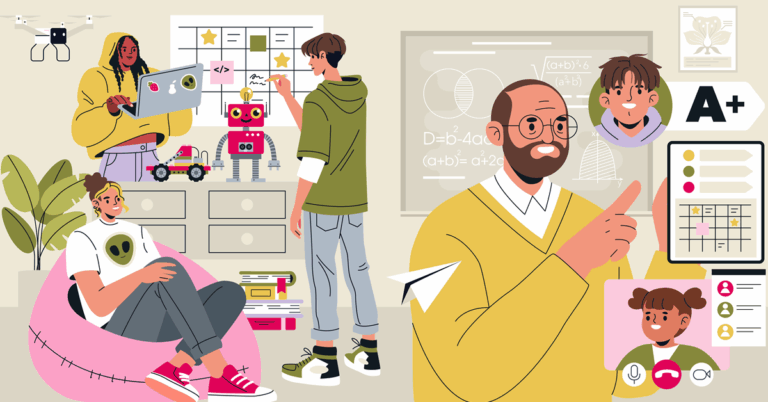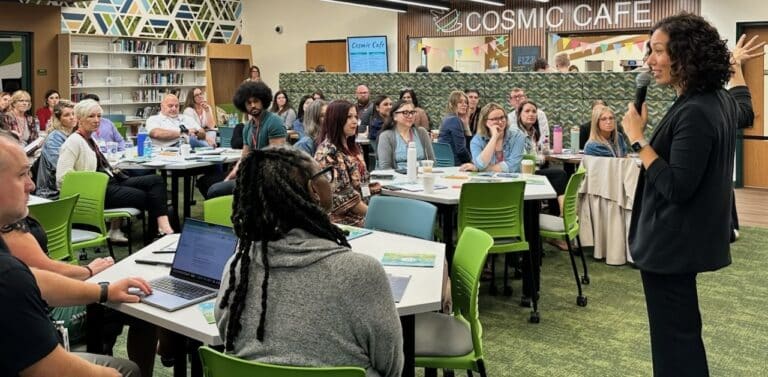When was the last time you had a moment to take a breath and consider why you are implementing a specific curriculum? Making a funding decision? Offering one professional learning opportunity over another? or pursuing a partnership with a local business?
Imagine that these decisions could be aligned with the priorities your learning community has collectively identified for the future of education within your local context.
That’s the power of a shared vision.
And there’s more at the heart of a shared vision than creating alignment. A shared vision unifies a learning community’s commitment toward a common purpose, ensuring ownership through collective decision-making and accountability. A shared vision is a community-created, common agreement about the preferred future that the learning community commits to realizing through its change efforts. Shared visions should feel daring and challenging to the status quo. While many organizations have crafted official vision statements, few have vividly described a transformed future. Articulate the vision that drives your work, even if that vision is different than what appears on your website.
How a learning community arrives at a shared vision, and who participated in its creation, matter. At KnowledgeWorks, we believe this work has to happen in partnership with individuals throughout a learning community: educators, families, business and community leaders and learners. And we can help – we support states, districts and communities in their efforts to make sustainable shifts to personalized, competency-based learning by working with them to identify their aspirations for the future and develop and commit to a shared vision.
Aspiration setting is a process in which a person, team or organization explores their hopes and preferences for the future. It articulates a desired outcome beyond the current state, fostering motivation and expansive thinking.
Shared visioning is a collaborative process in which a learning community or organization works together to create a common vision or set of goals. It brings together diverse perspectives to unify the learning community’s commitment toward a common purpose. Strategic integration and foregrounding of the shared vision ensure ownership and alignment through collective decision-making and accountability.
When learning communities engage in bold and creative thinking about what they hope will exist in the future, they become better equipped to create education systems that are truly different from what they have today. And when they co-create and commit to a clear and inspiring idea of what they will see if their work is successful, they establish a foundation for collaboration, action and accountability and a lens through which they can set priorities and make decisions.
Aspiration setting is an important step in the shared visioning process. It is possible, perhaps likely, that learning community members have different aspirations. Surfacing and articulating them, recognizing what’s shared and where there are differences, is important. The shared visioning process seeks to identify aspirational common ground and codify a shared vision in writing. Individuals within a learning community may have different aspirations for what a day in the life of a student might look like 10 years from now, and a shared vision provides a common language and purpose for realizing those aspirations.
Peter Boger, director for engagement at Penn State Sustainability, stressed the need to begin visioning and aspiration setting from a place of curiosity.
“You don’t have to know the answers to the questions before bringing the visioning process in, but it is helpful to know what kinds of questions you want to be asking,” said Boger.
After the adoption of Pennsylvania’s Science, Technology & Engineering, Environmental Literacy & Sustainability (STEELS) Standards, Penn State engaged KnowledgeWorks to facilitate aspiration setting with individuals from various departments at Penn State and United Nations Global Schools, along with K-12 educators, curriculum directors and school and building leaders from across the state. For Amanda Jolene Smith, director of K-12 engagement at the Penn State College of Education, aspiration setting allowed everyone involved to “push the envelope.”
“Once you step out of the classroom and the further you get from it, it becomes harder to think about how to make a difference in that space. We wanted to bring KnowledgeWorks in to stretch thinking and mindsets, uncover the ability to say, ‘Here’s what we can do,’” said Smith. “Let’s stay in the ‘can’ world and leave the ‘can’t’ world out of the situation. It was beyond a positive experience. Aspiration setting puts everyone in the right seat to think through what’s possible.”
While the aspiration-setting workshop had big outcomes – preparing educators for the STEELS standards and creating connections between Penn State and Pennsylvania educators – Boger highlighted how just knowing what they needed out of their time together was not enough.
“KnowledgeWorks helped us make sure we had shaped our questions correctly to get teachers thinking about what their district might look like in the future, the typical student, the unique things about their communities. That’s an important part of the visioning process,” said Boger. “You may know the outcome, but what are all the things you would need to know to be ready to push toward that outcome? The feedback that we got after the fact from teachers was that this wasn’t what they expected, but it was what they needed.”
Shared visioning and aspiration setting are two essential parts of the puzzle of systems transformation. Real change begins when everyone has a voice in the process and is challenged to use it to contribute to a preferred future for teaching and learning within their community.
Article written by former Senior Manager of Communications Jillian Kuhlmann





